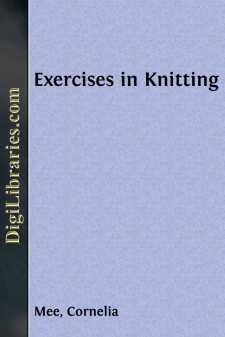Categories
- Antiques & Collectibles 13
- Architecture 36
- Art 48
- Bibles 22
- Biography & Autobiography 813
- Body, Mind & Spirit 142
- Business & Economics 28
- Children's Books 17
- Children's Fiction 14
- Computers 4
- Cooking 94
- Crafts & Hobbies 4
- Drama 346
- Education 46
- Family & Relationships 57
- Fiction 11829
- Games 19
- Gardening 17
- Health & Fitness 34
- History 1377
- House & Home 1
- Humor 147
- Juvenile Fiction 1873
- Juvenile Nonfiction 202
- Language Arts & Disciplines 88
- Law 16
- Literary Collections 686
- Literary Criticism 179
- Mathematics 13
- Medical 41
- Music 40
- Nature 179
- Non-Classifiable 1768
- Performing Arts 7
- Periodicals 1453
- Philosophy 64
- Photography 2
- Poetry 896
- Political Science 203
- Psychology 42
- Reference 154
- Religion 513
- Science 126
- Self-Help 84
- Social Science 81
- Sports & Recreation 34
- Study Aids 3
- Technology & Engineering 59
- Transportation 23
- Travel 463
- True Crime 29
Exercises in Knitting
by: Cornelia Mee
Categories:
Description:
Excerpt
As the number of stitches required to work each pattern will be mentioned, these patterns can easily be applied for any other purpose, and are most of them well adapted for doilies. Some of the most open patterns are suitable for Shetland shawls; and as the majority of the chair covers are now done in coloured wool, the colours and number of shades will be described; though, if wished in white, the linen thread, No. 1, is the proper material to be used.
I.
Large wooden pins are required for this pattern, which is done in double or eight-threaded wool, in 5 colours that contrast well—claret, gold colour, blue, white, scarlet; and 4 rows of each, worked in the order they are here placed. Cast on 71 stitches.
First row:—Seam 1, make 1, slip 1: this row is only to begin with, and is not repeated, the whole of the knitting being done as the
Second row:—Seam 2 together, make 1, by passing the wool round the pin, slip 1, and repeat. At the end of the row, if correctly knitted, there will be 1 stitch, which seam. When the colours have been repeated 6 times, the cover will be the proper size.
To finish it round, work fringe No. 2, work claret for the head, and put in two lengths of each colour in the fringe.
II.
Pins No. 10, 8 stitches to a pattern: 14 shades of orange 4-threaded German wool, beginning with the darkest, and working 6 rows of each: 4 plain rows to begin and end the cover; and 4 plain stitches at the beginning and end of every row, for an edge. These edge stitches are not mentioned with the pattern, but will be included in the number cast on. Cast on 112 stitches.
First row:—Make 1, knit 1, make 1, knit 2, slip 1, knit 2 together, pass the slipped stitch over, knit 2, and repeat.
Second row:—Seamed.
Third row:—Make 1, knit 3, make 1, knit 1, slip 1, knit 2 together, pass the slipped stitch over, knit 1, and repeat.
Fourth row:—Seamed.
Fifth row:—Make 1, knit 5, make 1, slip 1, knit 2 together, pass the slipped stitch over, and repeat.
Sixth row:—Seamed. Repeat from 1st row.
When 6 rows of each shade have been done, reverse them by continuing with the 2d lightest shade.
III.
Pins No. 10, 9 stitches to a pattern. Eight shades of scarlet four-threaded German wool, 12 rows of each, the shades to be arranged and reversed as No. 2. Cast on 116 stitches (this includes the 8 edge stitches).
First row:—Make 1, knit 5, knit 2 together, pass the wool twice over the pin, knit 2 together, repeat.
Second row:—Seamed. The stitches that were passed twice over the pin to be knitted only as 1 stitch.
Third row:—Knit 1, make 1, knit 4, knit 2 together, pass the wool twice over the pin, knit 2 together, repeat.
Fourth row:—Seamed as before.
Fifth row:—Knit 2, make 1, knit 3, knit 2 together, pass the wool twice over the pin, knit 2 together, repeat.
Sixth row:—Seamed as before.
Seventh row:—Knit 3, make 1, knit 2, knit 2 together, pass the wool twice over the pin, knit 2 together, and repeat.
Eighth row:—Seamed.
Ninth row:—Knit 4, make 1, knit 1, knit 2 together, pass the wool twice over the pin, knit 2 together, and repeat.
Tenth row:—Seamed.
Eleventh row:—Knit 5, make 1, knit 2 together, pass the wool twice over the pin, knit 2 together, and repeat.
Twelfth row:—Seamed, then repeat from the 1st row.
IV.
Pins No. 12. Sixteen shades of scarlet, four-threaded German wool, and 6 rows of each shade, to be worked in the same order as No....


